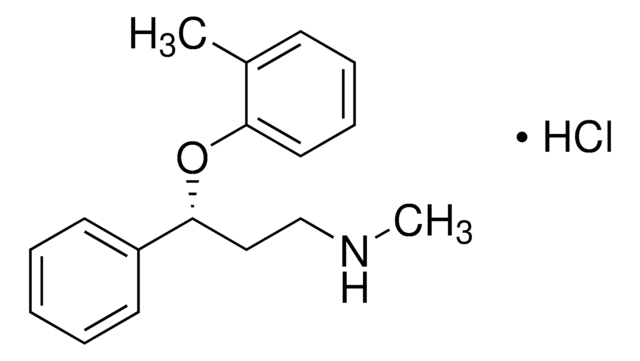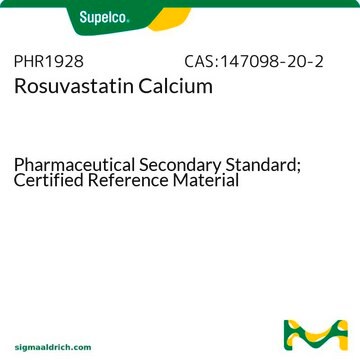PHR1679
Atomoxetine Hydrochloride
Pharmaceutical Secondary Standard; Certified Reference Material
Synonym(s):
(R)-Tomoxetine hydrochloride, (R)-N-Methyl-γ-(2-methylphenoxy)benzenepropanamine hydrochloride, Atomoxetine hydrochloride
About This Item
Recommended Products
grade
certified reference material
pharmaceutical secondary standard
Quality Level
Agency
traceable to Ph. Eur. Y0001586
traceable to USP 1044469
API family
atomoxetine
CofA
current certificate can be downloaded
packaging
pkg of 500 mg
technique(s)
HPLC: suitable
gas chromatography (GC): suitable
application(s)
pharmaceutical (small molecule)
format
neat
storage temp.
2-8°C
SMILES string
CNCC[C@@H](OC1=CC=CC=C1C)C2=CC=CC=C2.[H]Cl
InChI
1S/C17H21NO.ClH/c1-14-8-6-7-11-16(14)19-17(12-13-18-2)15-9-4-3-5-10-15;/h3-11,17-18H,12-13H2,1-2H3;1H/t17-;/m1./s1
InChI key
LUCXVPAZUDVVBT-UNTBIKODSA-N
Gene Information
human ... SLC6A2(6530)
Looking for similar products? Visit Product Comparison Guide
General description
Application
Atomoxetine hydrochloride may be used as a pharmaceutical reference standard for the determination of atomoxetine hydrochloride in pharmaceutical formulations by spectrophotometric method.
Biochem/physiol Actions
Analysis Note
Other Notes
Footnote
Recommended products
related product
Storage Class Code
11 - Combustible Solids
WGK
WGK 3
Flash Point(F)
Not applicable
Flash Point(C)
Not applicable
Choose from one of the most recent versions:
Certificates of Analysis (COA)
Don't see the Right Version?
If you require a particular version, you can look up a specific certificate by the Lot or Batch number.
Already Own This Product?
Find documentation for the products that you have recently purchased in the Document Library.
Our team of scientists has experience in all areas of research including Life Science, Material Science, Chemical Synthesis, Chromatography, Analytical and many others.
Contact Technical Service






